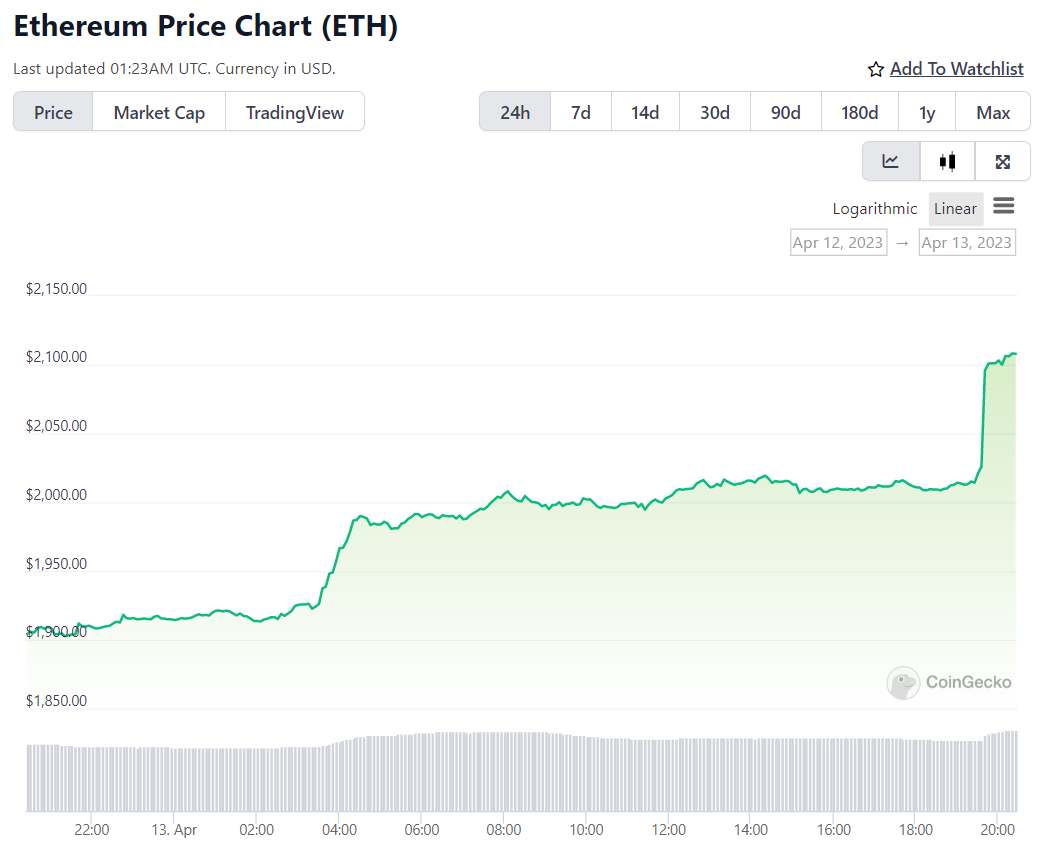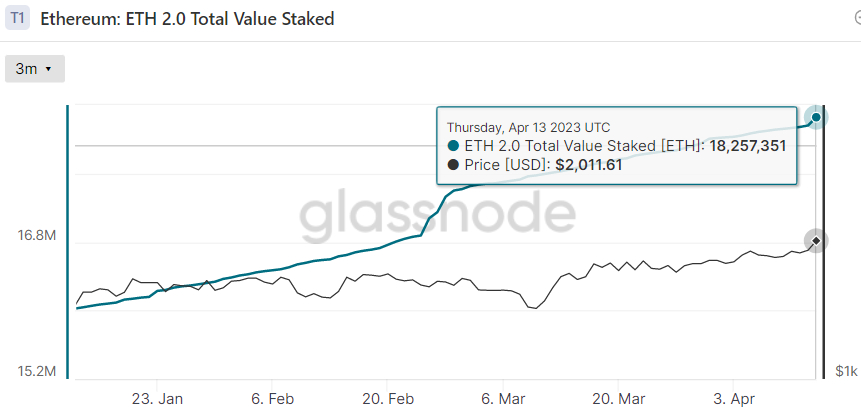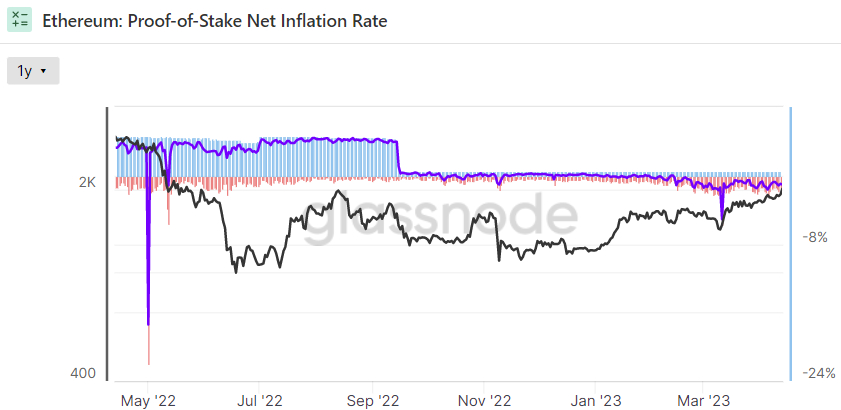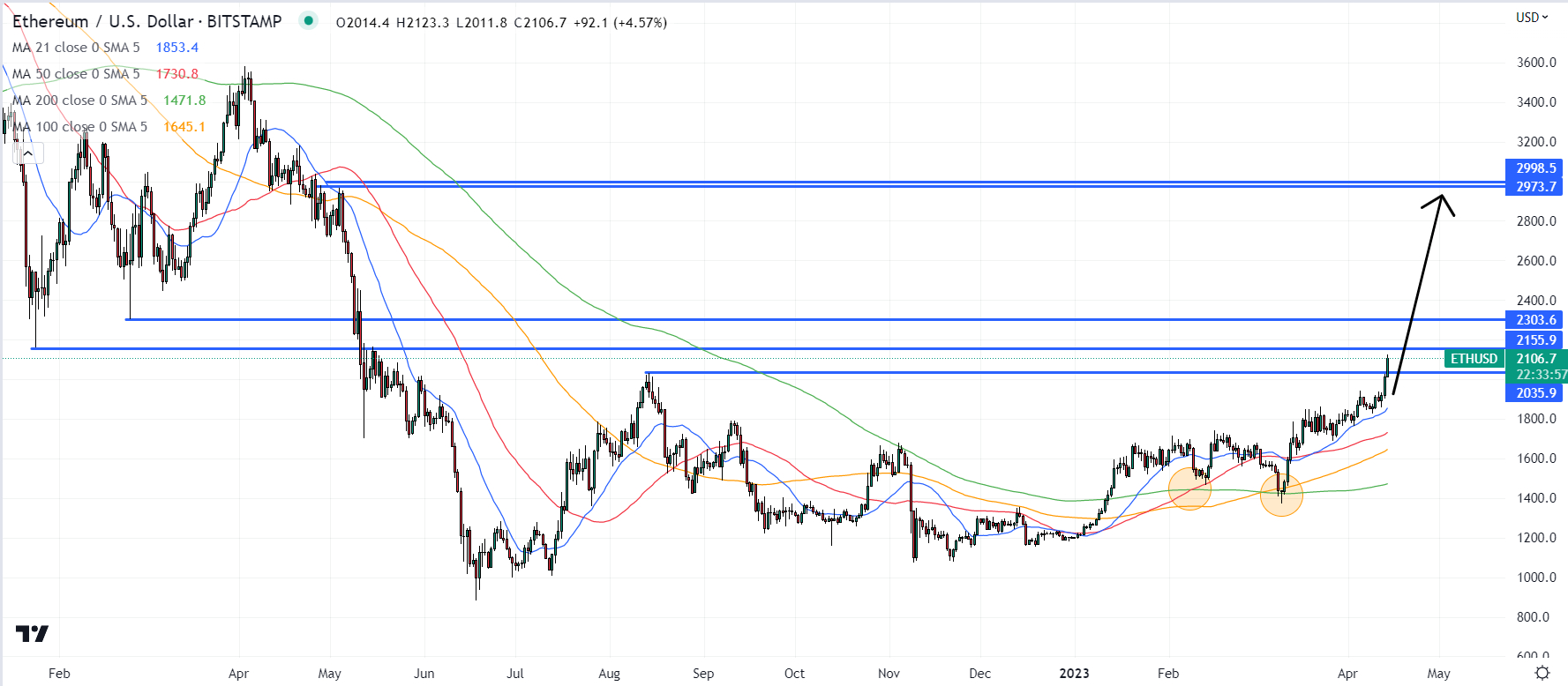Ether (ETH), the cryptocurrency that powers the smart-contract-enabled Ethereum blockchain, just surged above $2,100 for the first time since May 2022 amid positive post-Shapella update changes in the ETH supply.

Ethereum developers successfully implemented the so-called “Shapella” upgrade on Wednesday – Shapella being an amalgamation of the names of Ethereum’s consensus (Shanghai) and execution (Capella) layers.
Among other things, the upgrade means that staked ETH and ETH-denominated staking rewards can now be withdrawn from the staking smart contract for the first time since staking was enabled on the Beacon blockchain back in December 2020.
Some analysts had worried that the enabling of withdrawals would lead to a rise in short-term sell pressure in the Ether market, as stakers look to cash in on their accrued yield, as well as ETH price appreciation since December 2020 of around 200%.
However, on-chain data reveals that Thursday actually saw a near 100,000 jump in the number of ETH tokens staked on the Ethereum blockchain, the largest one-day increase in nearly two months.
That suggests that rather than a greater proportion of investors withdrawing their staked ETH to cash in, a larger proportion have actually interpreted the successful implementation of the Shapella upgrade as a green light to finally stake their Ether tokens.
When more ETH tokens are locked up in staking contracts, this increases the scarcity of unstaked ETH tokens that can be traded across cryptocurrency exchanges.
This should arguably boost the ETH price, which appears to have been the case in light of the latest market moves.
Upside in the ETH price is likely also related to relief that there hasn’t been a flood of unstaked ETH entering the market and adding to selling pressure.
ETH to Benefit From Deflationary Tailwinds
Now that staking withdrawals have been enabled, more ETH investors are expected to put their tokens into staking contracts to benefit from yield.
Investors in liquid staking protocols (i.e. buyers of Lido’s stETH token, for example) can expect yields in the 4-5% region, though this will fall as the amount of staked ETH rises.
As of Thursday, slightly more than 18.25 million ETH tokens are currently locked up in staking.

That only amounts to just over 15% of the total Ether supply of around 120.4 million.
Other comparable proof-of-stake blockchains like Cardano have significantly higher staking participation rates in the region of 60-70%.
Most analysts expect the Ether staking participation rate to rise towards these levels in the coming years, which, as described above, should lower the supply of circulating ETH (assuming ETH stakers generally leave their ETH in the contract for prolonged periods of time).
This could arguably be a big, almost deflationary tailwind for the ETH price.
And that’s before taking into account that the ETH supply actually is deflationary.
Back in August 2021, an update to the Ethereum blockchain introduced a new ETH burn mechanism – essentially, after this date, all ETH paid in transaction fees is removed permanently from supply.
This meant that rather than having a predictable inflation rate of around 4% (this was the annual reward given to miners back when Ethereum was still a proof-of-work blockchain), Ether’s inflation rate become unpredictable.
For the most part though, this inflation rate remained positive until the switch from proof-of-work to proof-of-stake in September 2022.
Rather than miners being rewarded with around 4% in new tokens each year, ETH stakers are now only rewarded with around 0.55% in new tokens each year.
Rising network activity this year, which has been pushing up transaction fees, has also been pushing up the burn rate.
And given the ETH issuance rate is so much lower now, it means that the net ETH inflation rate has been consistently negative in recent months.

It was last around -1.6%, but this could keep going lower if network activity and fees keep rising, which is likely as the crypto bull market matures (which should bring a lot of hype and users back to the Ethereum network).
Simply put, the ETH price is likely to benefit from significant dual deflationary tailwinds in the coming years as 1) more ETH is taken out of supply and put into staking contracts and 2) the ETH supply continues to deflate thanks to token burns.
Where Next for the ETH Price?
On-chain network utilization fundamentals still look a little weak despite the returning crypto bull market, with high transaction costs pushing more users towards Ethereum layer-2 scaling solutions like Polygon and Arbitrum, as well as competitor chains like Solana.
But deflationary ETH supply tailwinds coupled with optimism that Ethereum continues to make progress towards addressing its scalability issues mean that, on balance, Ethereum network fundamentals should remain supportive of the price for the foreseeable future.
With macro conditions also improving as US inflation keeps falling and recession risks rise, increasing the likelihood that a Fed rate cutting cycle is nearly here, medium to long-term risks seem strongly tilted in favor of continued ETH price upside in the coming months.
Short-term technicals are certainly also screaming positive.
ETH had been finding strong support at its 21-Day Moving Average in recent weeks, which technicians take as a strong vote of confidence by the market in short-term bullish price momentum.
All of ETH’s major moving averages are moving higher in consecutive order.
The strong rebound from the 200DMA in mid-March and golden cross (when the 50DMA went above the 200DMA) in early February are also positive medium to long-term technical signs.

With ETH/USD comfortably above resistance in the form of last August’s highs in the $2,030 area and already in the $2,100s, a melt-up towards the psychologically important $3,000 area in the coming weeks is a possibility.
Ether (ETH), the cryptocurrency that powers the smart-contract-enabled Ethereum blockchain, just surged above $2,100 for the first time since May 2022 amid positive post-Shapella update changes in the ETH supply.

Ethereum developers successfully implemented the so-called “Shapella” upgrade on Wednesday – Shapella being an amalgamation of the names of Ethereum’s consensus (Shanghai) and execution (Capella) layers.
Among other things, the upgrade means that staked ETH and ETH-denominated staking rewards can now be withdrawn from the staking smart contract for the first time since staking was enabled on the Beacon blockchain back in December 2020.
Some analysts had worried that the enabling of withdrawals would lead to a rise in short-term sell pressure in the Ether market, as stakers look to cash in on their accrued yield, as well as ETH price appreciation since December 2020 of around 200%.
However, on-chain data reveals that Thursday actually saw a near 100,000 jump in the number of ETH tokens staked on the Ethereum blockchain, the largest one-day increase in nearly two months.
That suggests that rather than a greater proportion of investors withdrawing their staked ETH to cash in, a larger proportion have actually interpreted the successful implementation of the Shapella upgrade as a green light to finally stake their Ether tokens.
When more ETH tokens are locked up in staking contracts, this increases the scarcity of unstaked ETH tokens that can be traded across cryptocurrency exchanges.
This should arguably boost the ETH price, which appears to have been the case in light of the latest market moves.
Upside in the ETH price is likely also related to relief that there hasn’t been a flood of unstaked ETH entering the market and adding to selling pressure.
ETH to Benefit From Deflationary Tailwinds
Now that staking withdrawals have been enabled, more ETH investors are expected to put their tokens into staking contracts to benefit from yield.
Investors in liquid staking protocols (i.e. buyers of Lido’s stETH token, for example) can expect yields in the 4-5% region, though this will fall as the amount of staked ETH rises.
As of Thursday, slightly more than 18.25 million ETH tokens are currently locked up in staking.

That only amounts to just over 15% of the total Ether supply of around 120.4 million.
Other comparable proof-of-stake blockchains like Cardano have significantly higher staking participation rates in the region of 60-70%.
Most analysts expect the Ether staking participation rate to rise towards these levels in the coming years, which, as described above, should lower the supply of circulating ETH (assuming ETH stakers generally leave their ETH in the contract for prolonged periods of time).
This could arguably be a big, almost deflationary tailwind for the ETH price.
And that’s before taking into account that the ETH supply actually is deflationary.
Back in August 2021, an update to the Ethereum blockchain introduced a new ETH burn mechanism – essentially, after this date, all ETH paid in transaction fees is removed permanently from supply.
This meant that rather than having a predictable inflation rate of around 4% (this was the annual reward given to miners back when Ethereum was still a proof-of-work blockchain), Ether’s inflation rate become unpredictable.
For the most part though, this inflation rate remained positive until the switch from proof-of-work to proof-of-stake in September 2022.
Rather than miners being rewarded with around 4% in new tokens each year, ETH stakers are now only rewarded with around 0.55% in new tokens each year.
Rising network activity this year, which has been pushing up transaction fees, has also been pushing up the burn rate.
And given the ETH issuance rate is so much lower now, it means that the net ETH inflation rate has been consistently negative in recent months.

It was last around -1.6%, but this could keep going lower if network activity and fees keep rising, which is likely as the crypto bull market matures (which should bring a lot of hype and users back to the Ethereum network).
Simply put, the ETH price is likely to benefit from significant dual deflationary tailwinds in the coming years as 1) more ETH is taken out of supply and put into staking contracts and 2) the ETH supply continues to deflate thanks to token burns.
Where Next for the ETH Price?
On-chain network utilization fundamentals still look a little weak despite the returning crypto bull market, with high transaction costs pushing more users towards Ethereum layer-2 scaling solutions like Polygon and Arbitrum, as well as competitor chains like Solana.
But deflationary ETH supply tailwinds coupled with optimism that Ethereum continues to make progress towards addressing its scalability issues mean that, on balance, Ethereum network fundamentals should remain supportive of the price for the foreseeable future.
With macro conditions also improving as US inflation keeps falling and recession risks rise, increasing the likelihood that a Fed rate cutting cycle is nearly here, medium to long-term risks seem strongly tilted in favor of continued ETH price upside in the coming months.
Short-term technicals are certainly also screaming positive.
ETH had been finding strong support at its 21-Day Moving Average in recent weeks, which technicians take as a strong vote of confidence by the market in short-term bullish price momentum.
All of ETH’s major moving averages are moving higher in consecutive order.
The strong rebound from the 200DMA in mid-March and golden cross (when the 50DMA went above the 200DMA) in early February are also positive medium to long-term technical signs.

With ETH/USD comfortably above resistance in the form of last August’s highs in the $2,030 area and already in the $2,100s, a melt-up towards the psychologically important $3,000 area in the coming weeks is a possibility.